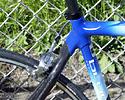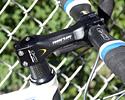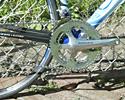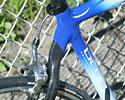
Recently on Cyclingnews.com |
On test: Blue Competition Cycles RC4, October 30, 2005
A ride that won't give you the blues
One of the new kids on the bike making block, Blue Competition Cycles has quickly built a reputation for making high-quality, high-performance road and triathlon bikes. Mark Zalewski took the Blue RC4 - the bike of US criterium champion Tina Pic - for a few laps of the block.
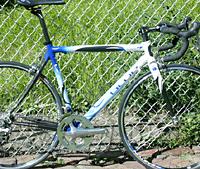
|
Blue Competition Cycles has only been in existence for a few years, but its reputation for making a quality high-performance racing bicycle has grown quickly. One need look no further then Quark's Tina Pic and her string of impressive U.S. criterium championships to see that the bike her team rides is built for speed, in every capacity. Even beyond the criterium, the company has an impressive roster of multi-sport athletes such as Sebastian Linke and Seth Wealing. Additionally, the Aerus line of carbon components from the Blue stable provides a nice complement to the frames.
With a sleek and extremely attractive paint scheme to complement the aerodynamically shaped tubes, the RC4 comes out of the box looking fast. "You're my boy, Blue!" (Sorry, had to sneak a reference to Old School somewhere.)
The RC4 frameset is built from Aerus Composites Conquest high modulus carbon tubes connected together with 7005 series aluminum lugs. The shaping of the tubing is quite stylish with an even more impressive paint scheme that is, of course, rather blue. However, the non-traditional tube shapes are nicely accented by a combination of white and blue paint along with a few areas of exposed carbon, making for an attractive display. An Aerus Composites carbon fork and Cane Creek integrated headset make-up the front end of the RC4. On the power end are a monobox chainstay and wishbone-shaped seatstay designs, which Blue claims increases both lateral rigidity and comfort.
Blue uses the "alternative" scale of sizing, offering six sizes from XS to XL. While this might leave some scratching their heads, a quick glance at the geometry of the seat and top tube lengths should be enough for you to go on. I normally ride a 56cm traditionally-sized frame and was unsure how the ML frame, with a 54cm seat tube and 55.5 effective top tube length would fit me. But I felt confident that this combination in a slightly sloping frame would be best, especially when it came to handling.
The parts
Blue Competition Cycles sent us the test bike just as it would ship to a dealer -- about 95 percent assembled, leaving the dealer with a minimal amount of work to get the customer riding and racing. After unwrapping all of the protective packaging, the true beauty of the RC4 stood out, and assembling the remaining pieces went quickly. The RC4 is available with three drive train options: Shimano Dura-Ace 10, Ultegra 9 and Ultegra 10. Just like the Quark cycling team's bikes, my RC4 was decked out in top-o'-the-line Dura-Ace 10.
Blue also deals in a very impressive line of carbon components from Aerus, including handlebars, stem, and seat post, and my RC4 came with all the carbon trimmings Blue offers. The Aerus C4 series departs from the traditional carbon construction of wrapping layers of carbon which often results in increased weight. By using a solid mold technique the company calls "HIPACT" (High Pressure Solid Compaction Technology) the strength and low weight of carbon can both be utilized.
I was most impressed with the look and feel of the Aerus C4 road handlebars, which feature a quite comfortable extra-wide top portion for climbing or just riding on the tops. The flip side of this is that the flattened top has less variety of comfortable positions -- for me only one. Too angled either direction gave me wrist pains when climbing on the top. Subsequently, the drops have to be in the same position. Therefore, for those like me that like their drops angled slightly toward the ground instead of flat, the tops became a little uncomfortable at an angle as well. You therefore have to decide on where your hands will spend more time. If you are headed for the hills, make sure the top is comfortable -- and if you are sprinting in a crit, get the drops in your favorite position. However, for only 200 grams of total weight, the bars are quite stiff and the carbon absorbs the road well.
The Aerus C4SQ carbon-wrapped alloy stem tips the scales at only 156 grams and also mimics the sleek, non-round design of the RC4's carbon tubing. The four bolt design makes adjusting the handlebar angle (as mentioned above) quite easy, which is nice when you have to travel around the country, turning your handlebars down for every flight.
The 172 gram C4ALB seat post also follows the design scheme of the stem with an aerodynamic layback profile. The layback distance of 40mm means that this seat post would be as comfortable on a road bike as a multisport machine. The unique design of the seat clamp and adjuster did take some getting used to, but after some inspection and tinkering, the desired seat angle was achieved. A small detail that I really enjoy about this seat post is a measurement system on the back of the tube, making resetting your seat to the perfect height quick and brainless after a long day of traveling. And since life is really all about the small things, I just had to include it!
The wheels for the complete bikes are supplied by Velomax. For the smaller sizes the Ascent II wheels are standard issue. With my ML the Orion II pair takes over for the increased weight (are they calling me fat?) but with only 58 more grams of Easton alloy. The 21mm profile rims have an offset spoke bed which Easton says increases rear wheel strength and stiffness by reducing rear wheel dish and providing higher overall spoke tension.
Speaking of spokes, in this age of creative spoke design, it is somewhat refreshing to see a more traditional lacing with 24 in the front radially and 28 in the back, crossed. The R3 hubs on the Orion ride ultra-smoothly on high-grade aluminum axles and hubs that are reportedly air-tight. Wrapped around the Orions are a pair of Maxxis Columbiere tires with their slightly grooved treads. These tires worked well in a variety of conditions, from wet to dry, smooth to rough. The Velomax Orions are a nice complement to the RC4, giving a strong and laterally stiff ride that is friendly in all conditions. These wheels are long-lasting workhorses that can take a beating day after day, whether racing or training. The only problem I experienced with these was in removal -- for some reason the skewer and dropout interaction proved difficult in removing the wheels. It was hard to tell which one was the cause, but I would say it was a little of column A and a little of column B. Either way, quick wheel changes were not always possible.
Hitting the road
Out on the road, and after the usual new bike adjustments to seat, handlebars and the like, the RC4 drew many an envious glance from the other riders along the 'seen and be seen' lakefront path where I began the test. Ah, to have a new bike again!
The frame and fork together weigh about 1.7kg -- with the final claimed weight topping only 15.8b (7.2kg), thanks to all those nifty and light carbon add-ons. I thought that maybe stiffness would be sacrificed to achieve this low weight, but the RC4 was just the opposite. The only difference I could find was over the roughest of roads, where shock absorption was not quite as good as some heavier bikes I have ridden. The mostly carbon stem and carbon handlebars did help compensate for this some, but on longer rides (more than four hours) I was starting to feel the effects.
Handling is an interesting dilemma with bikes -- numerous items contribute to it and can result in many degrees of steering ability and feel. One of the biggest factors in determining steering and handling quality is fork offset, or the distance that the front hub is forward of the steerer centreline. The larger the difference, the more stable the ride since physics dictate that centering forces increase in that distance. However, this also results in slower turning reaction, commonly referred to as 'twitchiness.' In short, your cruiser to the coffee shop would be better served with a high offset and your track bike would be better with less offset. On average most all-round racing bikes have an offset of 45mm. The RC4's Aerus fork has an offset of just 43mm, giving this bike very quick turning at high speeds but a little less handling as well. Chris Pic of Blue told me that the rationale behind this was, "To create a bike that would handle very nice and quick for all levels of riders from amateur to professional."
From my experience, this translated into a good thing for high-speed cornering in racing environments, even though it meant less overall smoothness and stability. In short, the RC4 is designed exactly for what it has been doing best for sprinters like Tina Pic the past two years -- transfer slight steering changes quickly down to the road to get around corners, lead-out trains or the occasional water bottle spinning around in the middle of the road. The shimmy I noticed rounding tight corners took some getting used to -- but once I adjusted my riding style the quick turning more than made up for this. However, on longer rides I would have liked a smoother-turning feel, especially when on easier spins in a group. Additionally, the 26.7cm of bottom bracket height is enough to clear most corners without clipping a pedal.
While all materials flex, the stiffness in the RC4, particularly around the all-important bottom bracket area, was quite enough. One only need to glance at the key areas to see the amount of carbon wrapped around the 7700 aluminum lugs. Jumping out of corners to get back up to speed was an easy job -- as was dropping into the drops for a straight sprint. Uphill riding was fine as the RC4 is light and responsive, and descending was stable with the RC4 passing the all-important 'top-tube slap' at downhill speeds. As mentioned earlier, the stiffness of the frame comes at a price... and for my longer rides, finding a comfortable position was not as easy.
Conclusion
Blue Competition Cycles makes bikes for just that purpose: competition. And these bikes are designed and built by actual racers who know what racers need and (more importantly) do not need in a racing machine. Though the RC4 is not ridden by a ProTour team, the costs of not sponsoring a team of that level might be passed on to the consumer. Sure the Shimano Dura-Ace equipped bike noses into the US$4,000 range, but the Ultegra option is only US$2,700, making it possible for you to get a well-made, high-performance racing bike without the high-performance cost. And when you consider this combined with the extensive component line, the RC4 will give you a well-rounded and competitive ride.
Pro: Crit-racing workhorse, good components, total won't break most
banks.
Con: Twitchy steering not for everyone's taste or needs, not as comfy
for long and bumpy rides.
Cyclingnews Rating: ![]()
Full specification: Blue RC4Frame: Blue RC4 Aerus Composites Conquest High Modulus Carbon Cranks: Shimano Dura-Ace, length 175mm |
MSRP: RC4 Dura-Ace US$4075.00; Ultegra US$2700.00; frame set US$1250.00Wheels: Velomax Orion II (for ML-XL) Stem: Aerus Composites C4SQ 1-1/8" (156g) Pedals: N/A More information: www.rideblue.com |

